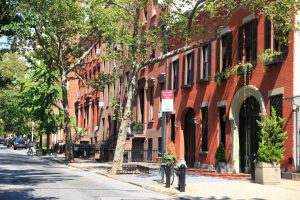Brooklyn Heights: 19th-Century Streets and 21st-Century Changes

When Mary Gannett was ready to retire from Book Court, the beloved Cobble Hill bookstore that she and her husband ran for more than 30 years while raising their family in the apartment above, she crossed Atlantic Avenue to Brooklyn Heights.
“It was a big transition in my life,” she said, “and it was a big change.”
Her marriage was ending. There was a lot of upheaval and construction in Cobble Hill. She loved everything old, but a real estate agent persuaded her to look at one of the few new buildings in the neighborhood, 172 Montague Street.
Now she rents a two-bedroom apartment there with panoramas of Lower Manhattan from her terrace and a 360-degree view from the roof deck. She and her partner, who is also retired, especially enjoy walking the Promenade, the walkway overlooking the East River that was created when Robert Moses ran the Brooklyn-Queens Expressway around the neighborhood instead of through it.
“That’s my spot,” said Ms. Gannett, 64.
Ask a longtime Brooklyn Heights resident what has changed and the answer is likely to be a cautious “not much.” Preservation efforts have been fierce for decades; Brooklyn Heights was the first New York City neighborhood to be named a Historic District, in 1965. The Brooklyn Daily Eagle, which was founded in 1841 and counts Walt Whitman among its former editors, continues to train a keen eye on the neighborhood, as do several hyperlocal blogs.
But there has been change here — quite a lot recent. One of the biggest drivers has been Brooklyn Bridge Park, a 1.3-mile space stretching along the waterfront, with playgrounds, sports fields and green spaces, as well as a hotel and condominiums, where longshoremen used to work the piers. Another is Brooklyn’s ascendance as an internationally known travel destination. A third is a boom in new buildings and renovations of factories and opulent old Brooklyn hotels, many sold in recent years by Jehovah’s Witnesses.
The views from the park and the Promenade are unparalleled: of Lower Manhattan, New York Harbor, the Statue of Liberty, Governors Island and, just to the north, the Brooklyn Bridge. Tour groups and film crews are now regular fixtures on the 19th-century streets.
Ms. Gannett, for one, thoroughly enjoys the mix. “The neighborhood is upscale but funky, with a lot of history. The buildings are beautiful. You hear every language on the Promenade,” she said. “You feel like you’re sharing your neighborhood with the world.”
Will McCormick, 31, the eCommerce manager for Whisk, an upscale kitchen supply store on Atlantic Avenue, is a fourth-generation Brooklynite. His great-grandfather worked a milk delivery route. His mother, a retired public-school teacher, still lives in his childhood home on Pierrepont Street.

The area has changed in “a lot of great ways,” he said. “Court Street went from desolate and sketchy to thriving.” Now it is a busy, prosperous-looking strip. The long-established Greenmarket at Brooklyn Borough Hall sets up nearby on Tuesdays, Thursdays and Saturdays.
“On Atlantic Avenue, you’ve still got Montero, the diviest of dive bars, where the longshoremen used to drink,” Mr. McCormick said. “And now you’ve got Middle Eastern markets, Caribbean food, galleries.”
“I always thought the park was a pipe dream,” he added, referring to Brooklyn Bridge Park. “I’m amazed that it’s happened, and it’s great.”
Hilary Hall, a children’s wear buyer for a retail apparel company, and her fiancé, Chris Reilly, a vice president of the fintech start-up Octane Lending, moved to the neighborhood last fall from San Francisco.
“We looked on the Upper West Side, but it was too competitive and pricey. We browsed Chelsea, the East and West Villages, but just didn’t find good value for what we were willing to spend,” said Mr. Reilly, who, like Ms. Hall, is 29. They settled on a one-bedroom apartment in a brownstone on Joralemon Street with high ceilings, built-in shelves and a brick fireplace; the rent is $2,625 a month. The small but recently remodeled kitchen has a gas stove, a microwave and a dishwasher.
“The churches give the neighborhood a feeling of permanence,” he said. “And you can hear the bells count through the hours on weekends.”
What You’ll Find
“Lately inventory has been unprecedented,” said Catherine Zito, an associate broker with Brown Harris Stevens. “Right now there are more than 30 townhouses on the market. People are moving for all different reasons, job transfers, downsizing, upsizing. So the townhouses are staying on the market for a little longer. It’s a buyers’ market right now.”
The housing stock has also grown with new development and the departure of Jehovah’s Witnesses, which has sold off its significant real estate holdings in the neighborhood and moved upstate. The organization had buildings of all sorts typical to the neighborhood: brownstones, carriage houses, factories. Renovation and repurposing of many of those buildings are expected to be complete in the next few years. Prices for luxury apartments at one, a former hotel at 171 Columbia Heights called the Standish, are listed as high as $11.65 million, according to the real estate website StreetEasy.

Deborah Rieders, an associate broker with Corcoran, said sales have been brisk at Pier House, the 105-unit condominium in Brooklyn Bridge Park, since it opened in 2015. “It’s one of the few full-service buildings in the neighborhood,” said Ms. Rieders, who lives there herself. “Every apartment has a west-facing view. Every unit is built as a little townhouse — duplexes with a separation between the bedroom and living areas.”
Some buyers, she said, were longtime residents of Brooklyn Heights or other brownstone areas who had been living in townhouses and loved the neighborhood but wanted to downsize. “Others were people who never thought they’d want to live in Brooklyn but were won over by the views.”
Andrew Friedman, an associate broker with Halstead, noted that the rental market was slow until recently, with plenty of apartments available, thanks to a glut of units built nearby, in Downtown Brooklyn. But now, he said, things are picking up. “There have been price corrections, and owners offering incentives,” so rentals are moving more quickly.
What You’ll Pay
The median sale price, according to StreetEasy, is $982,000, while the median rental price is $2,715 a month. But prices range as widely as the properties: In mid-May, 129 homes were for sale, with a studio on Remsen Street listed at $270,000 and a 6,000-square-foot 19th-century townhouseon Henry Street recently reduced to $7.25 million. And some new luxury apartments are listed for upward of $10 million.
Mr. Friedman of Halstead said rental prices have not changed much in the last year. As for sales, he said, the average price for a one-bedroom was $676,000 in 2017, and $734,000 in 2018. The average price for a three-bedroom apartment increased from $1.7 million in 2017 to $2.6 million in 2018 — a jump, he said, that reflected sales in new developments that came online in 2017 but closed in 2018.
The Vibe
Window boxes overflow with geraniums. The doors of the well-tended brownstones, townhouses and firehouses are painted cheery colors. Plane trees form natural arcs, shading streets and the green spaces of Cadman Plaza. Children skip along sidewalks after school lets out.
The massive Brooklyn Historical Society, soaring stone churches and the Brooklyn Public Library (now in temporary quarters on Remsen Street while the Brooklyn Heights branch on Cadman Plaza is reconstructed) testify to a couple of centuries of well-to-do residents.
There is a rich and continuing cultural history: Truman Capote, Carson McCullers, Gypsy Rose Lee, Norman Mailer, Arthur Miller and Marilyn Monroe were all residents. More recent famous residents have included Adam Yauch of the Beastie Boys (after he died in 2012, a playground where his father taught him to ride a bicycle was renamed in his honor); the former poet laureate Philip Levine, who died in 2015; and Lena Dunham, the creator of the HBO series “Girls.”
Devotion to the neighborhood abounds, which occasionally shows itself in activism against the increasing development. The rebuilding of the library on Cadman Plaza, with housing units planned in a tower above it, is one recent cause of foment. And in a recent show of local exasperation, the annual house tour was canceled: Participating residents were miffed that their rooms were popping up on Instagram.
Mr. Friedman said one of the appealing features, in contrast to other hot areas in Brooklyn, is the neighborhood’s stability. “It’s well preserved, it’s very settled,” he said. “Buyers don’t have to wonder which way it’s going to go.”
Go-to restaurants tend to be neighborhood hangouts like Noodle Pudding, Jack the Horse Tavern and Henry’s End. Yoga studios and gyms are also now part of the mix. And when school is out, helmet-wearing children flock to a vast blue expanse in Brooklyn Bridge Park for skateboarding lessons.
The Schools
P.S. 8, the Robert Furman School, has 910 students enrolled in grades K-8. According to statistics compiled by the New York State Department of Education, in 2016-2017, 71 percent of eighth-graders met state standards in English and 63 percent met the standards in math; citywide, the corresponding percentages were 41 and 38 percent.
The neighborhood is also home to the competitive private schools St. Ann’s, Packer Collegiate and Brooklyn Heights Montessori.
The Commute
As Robert Furman writes in his book “Brooklyn Heights: The Rise, Fall and Rebirth of America’s First Suburb,” ferries played a key role in the area’s development. Regularly scheduled ferries started running there from Lower Manhattan in the early 19th century. Today, you can commute by ferry from the Brooklyn Heights waterfront to Wall Street, East 34th Street and elsewhere in Brooklyn and Queens.
The neighborhood is a nexus of major subway lines, with stops on the R, 2, 3, A, C, 4 and 5 trains at various convenient corners. CitiBike docks are also plentiful.
The History
Social reform has a long history here. In the mid-19th century, the preacher Henry Ward Beecher was one of the most vocal abolitionists in the North. Abraham Lincoln, Walt Whitman (who also crusaded against slavery) and Mark Twain were among those who came to hear him speak in Brooklyn Heights.
Nearly a century later, a few blocks away on Montague Street, Branch Rickey, the general manager of the Brooklyn Dodgers, signed Jackie Robinson, the first African-American to play major league baseball. The building that housed the Dodgers headquarters is long gone, a bank branch now, but a plaque at the spot reads “Where the Dodgers Made Baseball History and Jackie Robinson Changed America.”
Source: New York Times/Jan Benzel

 USA 917-679-1211
USA 917-679-1211






 © Jackson Lieblein, LLC 2015.
© Jackson Lieblein, LLC 2015.
